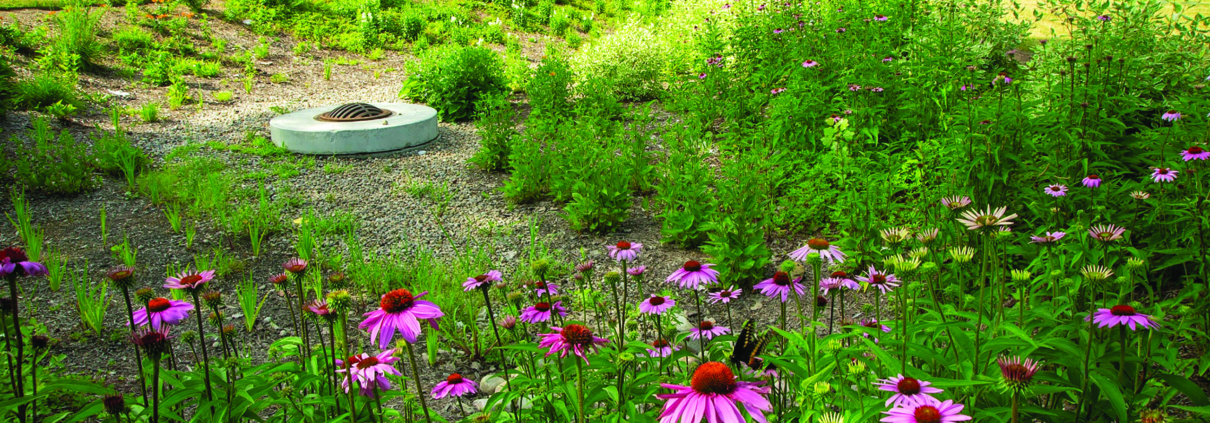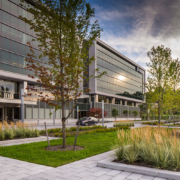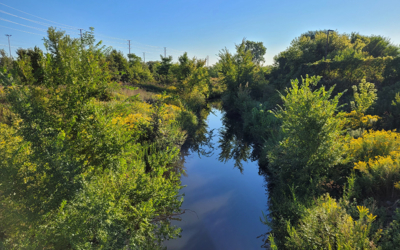Breathing Life into Engineering: An Introduction to Green Infrastructure
As climate change and other environmental crises escalate worldwide, individuals, businesses and communities everywhere are exploring ways to adapt to these challenges. While some are focused on solving these problems through technological advances, many others are looking to nature for inspiration, and with good reason: from bumblebees that developed long tongues to drink from tubular blooms to cacti that evolved to store water, the natural world has much to teach us about adaptation.
Engineered solutions that utilize natural processes to address environmental issues are known as green infrastructure. Green infrastructure typically uses the carbon sequestration, water filtration and temperature moderation abilities of healthy soil and native vegetation to manage challenges like stormwater runoff, urban heat island effect and atmospheric carbon. Unlike conventional responses to these issues, such as shoreline hardening or carbon capture technology, green infrastructure provides many co-benefits to people and wildlife and, if properly constructed and maintained, can often provide cost savings in the long term.
The most common forms of green infrastructure include:
Living walls and green façades
While we often conflate the idea of “green space” with “open space,” native plants that are integrated into a built environment still bring big benefits in the form of increased air quality, improved mental wellness and habitat for pollinators. Such plantings are especially important in cities, many of which are experiencing rapid growth and, with it, habitat loss.
Living walls (which feature grasses, perennials or shrubs planted right into walls or freestanding vertical structures) and green façades (where native vines, planted into the ground, are allowed to climb up a building’s walls) have become a popular way to benefit the environment with limited space, while also providing temperature and noise control, both indoors and around a building.
Key considerations: If not properly managed, the roots of living walls and green façades can impact a building’s structural integrity, so before installation, it is important to discuss plant selection and maintenance strategies with an experienced contractor. Most living walls contain built-in irrigation systems, and companies in areas with severe winters may want to consider a modular wall design, which allows for panels of plants to be removed and brought inside during cold snaps.
Learn more: Green Roofs for Healthy Cities is a nonprofit dedicated to promoting green infrastructure, including living walls, throughout North America. Their website features educational resources and a directory of professional contractors across the continent.
Green roofs
Rooftop runoff often contains contaminants such as heavy metals, dust and bacteria, which, during heavy rain events, can overflow from gutters or sewers into waterways.
Roofs planted with vegetation, known as green roofs, have become a popular way to address this issue. The soil and plants on a green roof can absorb up to 80% of rainfall, reducing the burden on sewage systems while also moderating building and outdoor air temperatures, extending the life of roofs, and creating habitat for birds and pollinators.
Key considerations: Green roof creation entails either adding pre-planted trays to a roof, or planting vegetation atop layers of insulation and soil. Depending on the method used, and the depth of the soil, green roofs can accommodate succulents, grasses, wildflowers, shrubs and even trees. Since these installations add weight to roofs, it is important to consult with an experienced engineer or contractor before getting started, and to have the roof maintained and inspected regularly.
Learn more: The Green Roof Research Center at Penn State, which tests the performance and benefits of green roofs across campus, is the only research center of its kind in North America. The center’s website features extensive research on best practices for roof creation and maintenance.
Bioswales and rain gardens
As with roofs, the impervious materials used in sidewalks, driveways and parking lots can lead to contaminated runoff, containing motor oil, road salt and pesticides, entering waterways.
Rain gardens and bioswales, which feature native vegetation planted in a depression, capture and filter this runoff before it returns to the water table or a nearby waterway. By capturing stormwater or slowing its flow, these installations also decrease the risk of flooding and erosion. Although bioswales and rain gardens serve similar purposes, they differ in design. Rain gardens are designed to draw water directly down into the soil. Although bioswales’ soil and plants do absorb some stormwater, their sloped design is meant to redirect much of the runoff toward a drain — or into a connected rain garden!
Key considerations: Rain gardens are best suited for areas with fast-draining soil — creating one in clay or other poorly drained soil can result in pools of stagnant water, which are conducive to mosquito breeding. Gardens should also be kept at least 10 feet away from buildings to protect foundations from water seepage. Management of rain gardens and bioswales will be similar to that of other native gardens (e.g., watering during the first year, invasive species control), although teams may wish to put more effort toward soil health to ensure proper drainage (check out WHC’s healthy soils webinar for inspiration).
Learn more: A local agricultural extension office is a good resource for researching the soil types and native plants found in your area. The USDA National Institute of Food and Agriculture website contains a state-by-state extension directory.
Living shorelines
About 40% of the world’s population lives within 90 miles of the ocean, and eight of the world’s 10 largest cities are in coastal regions. To protect properties in these areas against storm surges, erosion and the looming threat of sea level rise, many governments and private landowners have turned to shoreline hardening solutions like seawalls and bulkheads. This type of gray infrastructure, however, decreases habitat for aquatic wildlife that depends on coastal vegetation, and can exacerbate erosion along unprotected parts of the coast.
As such, many landowners are choosing to instead fortify their coasts with living shorelines. This approach involves installing oyster reefs or planting native marsh vegetation to weaken breaking waves while also trapping sediment to counteract any erosion that does occur, helping to protect properties while also fostering healthy coastal habitat.
Key considerations: In areas with a high flooding risk, a living shoreline alone may not provide sufficient protection. Coastal fortification should, in these cases, be approached as a continuum, with intermediate options (such as combining a small stone breakwater with coastal vegetation) often being the best course of action. Depending on the scale of a living shoreline project, it may be necessary to obtain both a state-level permit and one from the Army Corps of Engineers. A local marine contractor can help you navigate this process.
Learn more: The NOAA website features a wide variety of resources on living shorelines, including pricing and permitting information, case studies of successful projects and, for high-risk areas, guidance on combining green and gray infrastructure.
Next Steps
Installing green infrastructure, especially projects that require permits or inspections, is a big decision that requires thorough research and planning. Once implemented, however, these projects provide invaluable environmental, economic and social benefits. To demonstrate how companies across the country have implemented green infrastructure and other nature-based solutions, WHC has published white papers on natural climate solutions and green infrastructure. For insights on starting a green infrastructure project of your own, read our stakeholder-informed project guidance or contact WHC Consulting today.





